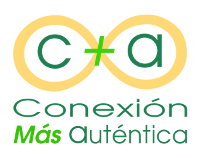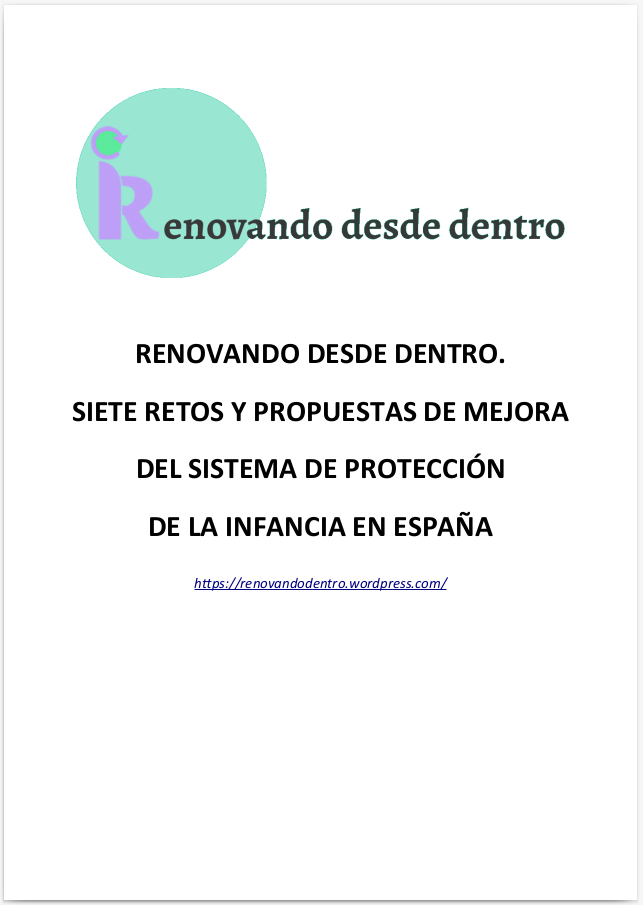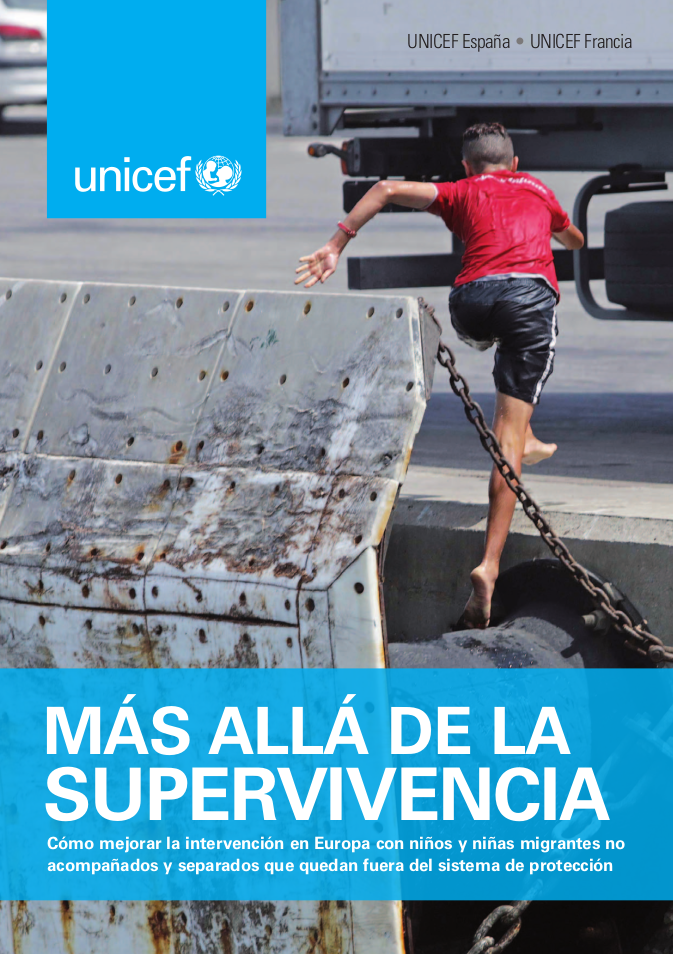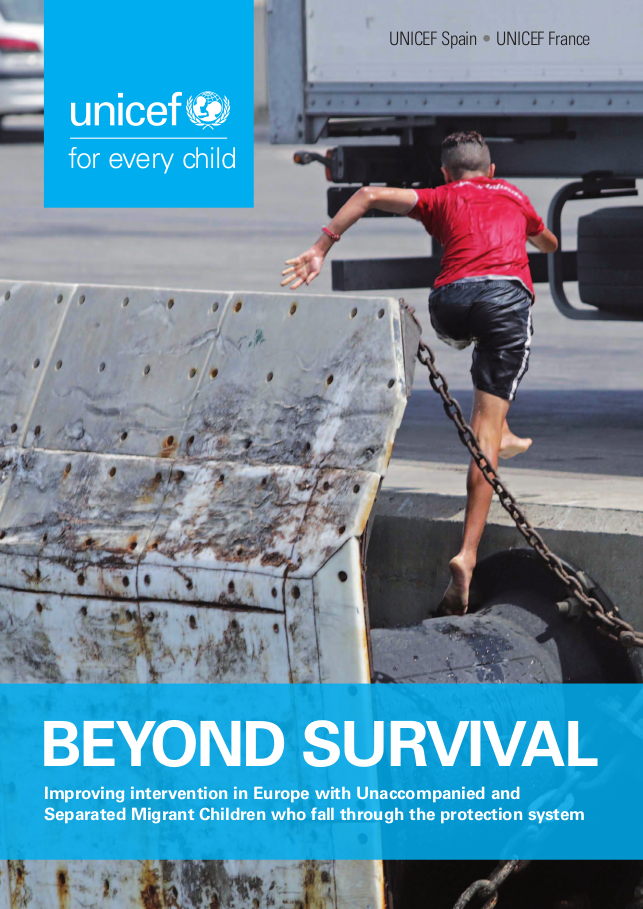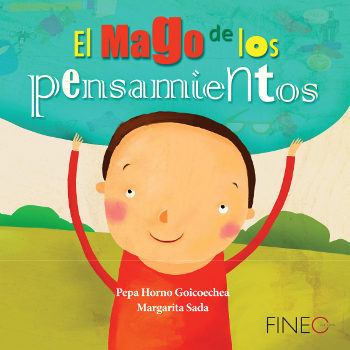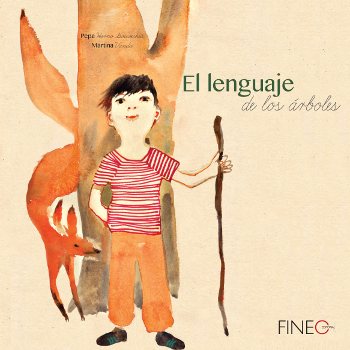Label: Other Texts
Guide “Voices for change. Methodological guide for consulting children, girls and adolescents in residential care”, by Pepa Horno and F. Javier Romeo, for UNICEF Spain
7 October 2021.
Tags: Agenda actual, Interpersonal communication, Education, CI Spirals, My Classifieds, child protection, Other Texts
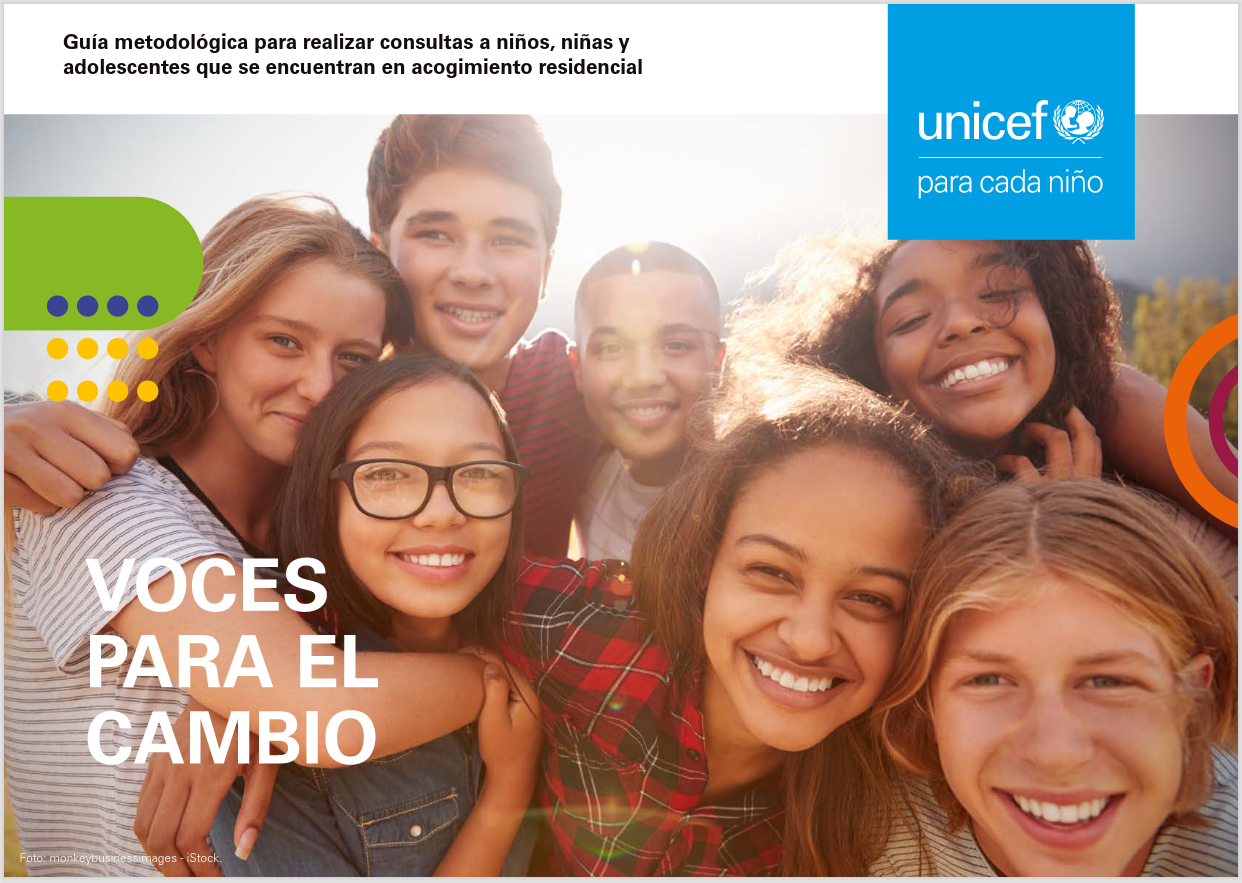 as usual, In this blog I share elements that cross my work in Spiral Consulting Children with other personal and professional interests. In this case I have the satisfaction of sharing the guide Voices for change. Methodological guide for consulting children, girls and adolescents in residential care, what we make Pepa Horno and I stop UNICEF Spain.
as usual, In this blog I share elements that cross my work in Spiral Consulting Children with other personal and professional interests. In this case I have the satisfaction of sharing the guide Voices for change. Methodological guide for consulting children, girls and adolescents in residential care, what we make Pepa Horno and I stop UNICEF Spain.
It was a satisfaction to receive the commission to systematize this methodology in writing in an affordable way.. Part of our work when accompanying public and private entities of protection systems here in Spain and in other countries in their improvement processes consists of having the eyes of their protagonists: children, girls and adolescents living in protection centers. And they are specialists in their own lives, and often the institutions forget to ask them, unfortunately.
That is why it is a great joy that UNICEF Spain, within its work in promoting child and youth participation, has invited us to present a simple methodology to consult these children, and adolescents. We talk more about it in the blog of Spiral Consulting for Children.
Inside it is a technical and practical guide, For me, the aspect of the interpersonal communication: how can we adults talk, how we can create the right space and how we can listen to children, and adolescents. The words we use can open communication or close it, That is why the formulas that we present are very clear.: respect, inclusion and protagonism of the children themselves, and adolescents.
And we have also insisted on flexibility and adaptation to all children, and adolescents, providing guidelines to accommodate the intervention to functional diversity, cultural diversity (especially the unaccompanied migrant boys and girls) and those with mental health issues and trauma. Their voices, as we say in the title, well heard, can make a change for the better in their lives.
I hope you like it and that you find it interesting.
For a conscious use of social networks: “Digital Minimalism” of Cal Newport
14 September 2021.
Tags: Other Texts, Experiences
This summer I needed to disconnect, and i got it. on a mental level, but also electronically. And it has been largely thanks to reading Digital Minimalism, of Cal Newport, an author whose line of thought I admire, I try to put into practice and I recommend.
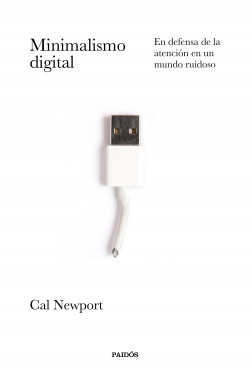 through this book, which has the suggestive subtitle “In defense of care in a noisy world”, I have shaped the kind of relationship I want to have with social media: use them consciously, taking advantage of the possibilities of connection and contact with other people and with interesting organizations, but without losing control of my time, of my care or my emotional well-being. It is written in prose that combines rigorous research exposition with entertaining anecdotes that make key points concrete..
through this book, which has the suggestive subtitle “In defense of care in a noisy world”, I have shaped the kind of relationship I want to have with social media: use them consciously, taking advantage of the possibilities of connection and contact with other people and with interesting organizations, but without losing control of my time, of my care or my emotional well-being. It is written in prose that combines rigorous research exposition with entertaining anecdotes that make key points concrete..
And the best thing is that it is not about leaving all social networks, but to limit its use to adequate levels for our brain. The book begins with a proposal 30 days without social networks and then gradually introduce them, in a manner appropriate to our interests. I have been all August without opening my accounts Twitter and of LinkedIn and, Although it was hard at first, I have arrived renewed to September. Now I open them two or three times a week, with intention, seeing the topics that really interest me, and I have already discovered several interesting initiatives without suffering from the tense messages of the “trending topics”.
And the best thing is that Cal Newport does not stay in “stop the inappropriate use of social networks”, but it also advances four guidelines to take advantage of the time that is freed up for us:
- Take the opportunity to be alone, at internal connection time.
- leave the “likes” as a form of relationship and replace them with direct conversations (in person, by phone or video call), in real interactions more adapted to our emotional capacities.
- Cultivate healthy leisure, that gives us energy instead of taking it away.
- Paying conscious care to our attention, which is limited. Instead of wasting it on activities that do not bring us much, concentrate it on what makes us grow and take care of each other.
So if you see that I use social networks less, you will know that I am taking care of my attention. And if you want us to discuss something, Better by phone or in person than by social networks, do you seem to?
Good start to the school year,
Community, growth and awareness: a personal vision of the project “Renewing from within”
19 May 2021.
Tags: CI Spirals, Focusing international, My Classifieds, child protection, Other Texts, Webs
Online life has helped us create new virtual communities.
More than a year ago I received the invitation to be part of a reflection group on children in the protection system in Spain, coordinated by Alberto Rodriguez and Javier Múgica and in which we participate Antonio Ferrandis, mi partner of CI Spirals Pepa Horno, Marta Llauradó and my almost double namesake F. Javier Romeu Soriano. After these months of online meetings and multiple emails and drafts, last week we jointly published the founding document, Renewing from within. Seven challenges and proposals to improve the child protection system in Spain. The text speaks for itself, and can be downloaded from web page of “Renewing from within”.
Here I want to talk about something a little different: of the process itself. And I'll sum it up in three words: community, growth and awareness.
Community is what we have been creating. It has a part of chance, having met for child protection issues in different spaces. But it also has a part of intention. Make room for online meetings. Write each one their part of the document and revise the texts of the rest. share views, concerns and possible responses. Little by little we have been deepening our relationships, developing a common language that incorporates our different personalities and sensitivities. And we believe that part of the improvements in the protection system go precisely through creating community in many other spaces, with the kids, girls and adolescents and their families, within professional teams and intervention networks.
Further, we have advanced with a perspective of growth. Each person in our group has been collaborating and accompanying processes of the protection system for many years. That's why we can talk about the shortcomings, of the weak points that harm children, girls and adolescents and the families whom it is intended to protect. But we also remember the progress, the changes, sometimes very small, that make some aspects improve. That is why the document wants to collect both the challenges that we see in Spain and some proposals that we know, by personal or professional experience, that have worked before. And this process also makes us who reflect in a group grow.
Why, in the end, It is about developing the consciousness. when we have a “conscious gaze”, as my good friend says and partner at CI Spirals Pepa Horno, we see reality in a deeper way. We identify what happens in children, girls and adolescents and their families, but also in the professional teams and in the systems that would have to provide them with protection and support. And we also recognize what happens inside us, to channel intuitions and sensations towards concrete proposals that improve the lives of many people. We can't do this alone, we need a safe environment, community, help us move forward, to ask ourselves new questions and discover new answers.
From here I send my thanks to this magnificent team, and to life for making it possible.
And I invite you to read the document and pay attention to the following steps (we will be publishing monthly blog entries to continue delving into the different proposals). I see you on the website “Renewing from within”.
in celebration,
A personal view on “Beyond survival. How to improve the intervention in Europe with unaccompanied and separated migrant children who remain outside the protection system ”, by F. Javier Romeo and Pepa Horno for UNICEF
20 October 2020.
Tags: Agenda actual, CI Spirals, Focusing, In English, My Classifieds, Other Texts, Experiences
[Click here to read this post in English.]
The document Beyond survival. How to improve intervention with unaccompanied and separated migrant children who are left outside the protection system, what Pepa Horno, my partner in Childhood Consulting Spirals, and I have written for UNICEF Spain and UNICEF France, just posted, and is available in two versions:
- Download the original English version of Beyond Survival. Improving intervention in Europe with Unaccompanied and Separated Migrant Children who fall through the protection system.
- Download the Spanish translation, Beyond survival. How to improve intervention with unaccompanied and separated migrant children who are left outside the protection system.
This is a technical publication that has to do with Child Protection, social intervention and human rights. In fact, We have the ideas and conscience of about a hundred professionals in the International Workshop in December 2019 en Madrid, that I helped facilitate (we explain more in our CI Spirals blog post). However, it is also a very personal document for me.
On the one hand, children, Unaccompanied and separated migrant girls and adolescents have a very special place in my heart. I worked in Morocco for several years with children, girls and adolescents living on the streets and I know the difficulties they have there, and what makes them risk their lives for the possibility of having a better future. I have also worked for several years in Madrid with adolescents at social risk, and many of them were migrant boys and girls with no family references, so I have accompanied their steps in the difficulties they encountered to build a good future in Spain. And to this day I still enjoy being able to speak with them in Moroccan Arabic, a language that I really like. I hope that this document helps professionals and also the general public to have a compassionate look towards these children., and adolescents, and to worry about their welfare. (You can read more about my career path on my LinkedIn profile).
On the other hand, currently this is a very sensitive issue, due to multiple factors. As lead editor, I have repeatedly used do Focusing as a process for structuring ideas and finding the right formulations. The keys to more protective narratives need to come from a consciousness firmly rooted in the body. Hope this brings clarity and also a deeper perspective to this whole topic, especially if the more intricate parts manage to be a little more explicit.
In conclusion, it has not only been a professional challenge, but also a very personal process. I hope you enjoy it.
A personal view on “Beyond Survival. Improving intervention in Europe with Unaccompanied and Separated Migrant Children who fall through the protection system”, by F. Javier Romeo and Pepa Horno for UNICEF
20 October 2020.
Tags: Agenda actual, CI Spirals, Focusing, In English, My Classifieds, Other Texts, Experiences
The document Beyond Survival. Improving intervention in Europe with Unaccompanied and Separated Migrant Children who fall through the protection system, that Pepa Horno, my colleague at Espirales Consultoría de Infancia, and me have written for UNICEF Spain and UNICEF France, has just been published, and it is available in two versions:
- Download the original version in English of Beyond Survival. Improving intervention in Europe with Unaccompanied and Separated Migrant Children who fall through the protection system.
- Download the translation into Spanish, Beyond survival. How to improve intervention with unaccompanied and separated migrant children who are left outside the protection system.
This is a technical publication that has to do with Child Protection, social intervention and human rights. In fact, we counted with the ideas and awareness of nearly a hundred professionals at an International Workshop in December 2019 in Madrid, that I co-facilitated (we explain more about it in our blog post in Espirales CI). However, it is also a very personal document for me.
On the one hand, Unaccompanied and Separated Migrant Children are very dear to me. I worked in Morocco for several years with children in street situation and I know of the difficulties there, what makes them risk their lives for the possibility of a better future. I also worked for several years in Madrid with at-risk youth, and many of them were unaccompanied migrant children, so I accompanied their steps in the difficulties of building a good future for themselves in Spain. And I still enjoy being able to speak with them in Moroccan Arabic, a language that I like very much. I hope that this document will help other professionals and the general public to have a compassionate regard to these children, and to care for their wellbeing. (More about my career path in my LinkedIn Profile).
On the other hand, this is currently a very sensitive issue, due to several factors. As main writer, I have used extensively Focusing with myself as a process to structure the ideas, and to find the adequate wording. The clues for more protective narratives need to come from an embodied awareness. I hope that this will bring clarity and also a deeper perspective to all this subject, with some of its intricacies made a bit more explicit.
In conclusion, it has been not only a professional challenge, but also a very personal process. I hope that you will enjoy it.
Story “The Wizard of thoughts” Pepa Horno on listening to the body by caressing
11 July 2016.
Tags: Education, CI Spirals, Focusing, For boys and girls, For parents, Textos Focusing, Other Texts
In line continue to celebrate the publication a year ago tales of Pepa Horno, my good friend and partner in Spiral Consulting Children (where we work on issues of affective education in childhood), This complements entry the previous one, referring to his book The language of trees. this story, The Wizard of thoughts, It has been published by the Editorial Phineus with illustrations Margarita now.
Pepa same account his intention for this book with the following words:
The Wizard of thoughts He speaks of fondling, and how caresses and massages serve to emotional self-regulation, for these children than adults say they still do not stop, who fail to sort their thoughts, or silence them or concentrate ... For these children have a "magic" trick to put some order within himself. In those thoughts that basically are but the fruit of his extraordinary sensitivity.
To this I add that it is a story that can be adapted perfectly to teach Focusing boys and girls for the following reasons:
- Presents a positive and welcome sight of thoughts, sensations, feelings, emotions and experiences in general with children (and we also have adults): what is within us it makes sense if you provide adequate listening.
- Children can do concrete things to pay attention to their internal experiences, so these calm down (and, although not explained in the story, Also to be deployed), and those who are around him can accompany.
- Internal experiences are accompanied by more effectively with any physical action. Pepa proposed in the story caresses the areas involved (head of the protagonist, in this case), but explained on the last page, “Words for the soul of adults”, there may be many other ways, whenever it involves the body.
So I heartily recommend this book as a way to present the Focusing in a manner adapted to children.
I hope you will like it as much as me,
Xavier
Story “The language of trees” Pepa Horno to accompany the child duel (and for all ages)
13 June 2016.
Tags: Mourning, CI Spirals, For boys and girls, For parents, Other Texts
It has recently completed the first anniversary of the publication of the story The language of trees of Pepa Horno, my dear friend and partner in Spiral Consulting Children (where we work on child protection issues). this story, published by the Editorial Phineus and illustrated by Martina Vanda, had several presentations, and the first was in the Book Fair of Madrid 2015 at this time, so I thought proper to remember with this blog.
Pepa presents the book as follows:
The language of trees about death. Or rather on the thread of love that binds either side of life. He speaks of people who have the heart divided, "Half on land and half in heaven", and it is written for many children (those who are children now and those other children hidden under the skin of adults) with his heart so.
I want to highlight three aspects that recommend this story (and that is why I have already given more than one occasion):
- The importance of discovering a symbolic link to the deceased, can be grown in life or after death has occurred. Never too late to create a ritual that produces us feeling connected to those we still alive.
- Body dimension bereavement, masterfully displayed targeted. Take a walk, move around the field, gestures with the body… It helps us to better process losses, regardless of age.
- Tenderness that permeates the work invites us to take care of the relationship in every situation of mourning with all children: with those who are age, and who took our children and girls indoor inside (and also they need your attention).
For all this and much more is a book I consider recommended reading, and especially to have on hand when losses occur in the environment.
Hope you enjoy it as much as the IM.
Xavier
My article on “Children and death”
31 October 2015.
Tags: Interpersonal communication, Mourning, Education, My Classifieds, For boys and girls, For parents, Psychotherapy, Therapy, Other Texts
In these final days of October the theme of death more frequently in the lives of children arises. Since the celebration of the Day of the Dead in certain families to all events of a different color of the Halloween, the reality is that it is a time when children can ask questions about death, and it is convenient to have prepared certain attitudes and listening spaces and answers.
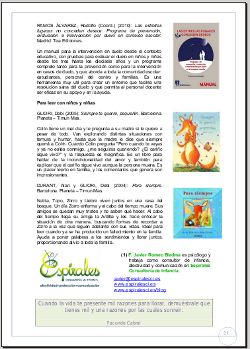 I wrote in 2011 an article that recovery here, “Children and death”, to remember some useful clues. In the article, published in the journal Our corner of 0-6 - ACCENT directed Childhood Education, They explore three key areas:
I wrote in 2011 an article that recovery here, “Children and death”, to remember some useful clues. In the article, published in the journal Our corner of 0-6 - ACCENT directed Childhood Education, They explore three key areas:
- The perception of death at different ages (between zero and six years, which it is the subject of the magazine).
- Some basic guidelines to accompany children to death.
- recommended reading, separate readings for families and professionals and stories to read with children.
Article framing and start with this paragraph:
For a long time it was thought that children did not suffer grieving process until older ages. However, research in the field of addiction have shown that pass through grieving process from the earliest ages, although it does not manifest like adults until later. Therefore it is necessary to speak of death (and not hide it for fear of damaging them) when it happens (or when it will happen, in the case of terminally ill), to understand 1) that the person is definitely going and 2) that the person does not leave voluntarily, and also so they can say goodbye, because if these concepts are not clear and not a farewell occurs, a pathological mourning may appear. And so it is important that we listen and pay attention to what happens inside when the death occurs in their lives.
[cite as: ROMEO BIEDMA, Francisco Javier (2011): "Children and death" Our corner of 0-6 - ACCENT, 60, 17-21.]
I hope that these reflections will serve to accompany this topic to children in your environment. Death is an inevitable part of life, and how better integrate, They will live more fully, our children and us.
I wish you a commemoration consciousness,
Restorative Practices at school, a new way to resolve conflicts
5 May 2015.
Tags: CNV, Interpersonal communication, Education, In English, For parents, Texts CNV, Other Texts, Videos, Webs
Most disputes can be resolved in a satisfactory and beneficial way for all parties, provided that the necessary resources and time are dedicated. That's my personal and professional experience years learning, practicing and transmitting Nonviolent Communication. It's as basic (not easy) as the necessary conditions for that resolution occurs. For me there are several must-haves, which can be summarized as follows:
- An appropriate methodology, to allow all parties involved feel safe and respected in their rights.
- Professionals with experiential training in mediation and deep listening skills and “translation” messages to make them easier to listen to each person.
- A supportive community restorative processes, devoting time, spaces, human Resources, training…
- People willing to resolve conflicts in a way that ultimately all parties feel heard and that all parties leave satisfied with the solution.
So for me it is a joy to share the resources developed by a large community of people in the neighborhood are Gotleu in Palma de Mallorca (Mallorca), They are collecting and how they have worked each of those elements.
In this video you can see how they have been involved, with the revitalization of Institute for Coexistence and School Success (the Institute for Coexistence and School Success in Castilian) Government of the Balearic Islands, from the faculty of schools of Primary Education, Elementary and Secondary, students of all ages, the families, and Social Services, police, University and other significant social groups. A mosaic of voices, We make us an idea of the experiences of the creation of that network security in a socially vulnerable environment, and we see some results.
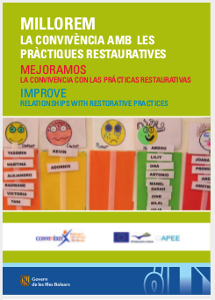 For a more systematic view, is the publication containing the fundamentals. Published in Catalan, Castilian and English as part of a European project this subject, the Guide to improve coexistence with Restorative Practices / Guide Mejoramos coexistence with the practices restorative develops the theoretical aspects of Restorative Practices, more accurate data and provides concrete examples and suggestions for further reading for more information.
For a more systematic view, is the publication containing the fundamentals. Published in Catalan, Castilian and English as part of a European project this subject, the Guide to improve coexistence with Restorative Practices / Guide Mejoramos coexistence with the practices restorative develops the theoretical aspects of Restorative Practices, more accurate data and provides concrete examples and suggestions for further reading for more information.
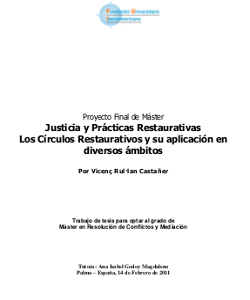 And to deepen the Restorative Circles, a practice of conflict resolution originated in the social dimension Nonviolent Communication, you can read the interesting monograph Justice and Restorative Practices. Restorative Circles and their application in various fields, written by Vicenç Rul·lan, a trainer who I have the pleasure of meeting, on the video and in the Guide, and he is a member of the Association of Restorative Justice Practices and Islands (to page Castilian and in Catalan, with several resources more). A good introduction, to further deepen this particular model. And you can also watch videos (English) on the official website of the creator of the Restorative Circles, Dominic Barter, RestorativeCircles.org.
And to deepen the Restorative Circles, a practice of conflict resolution originated in the social dimension Nonviolent Communication, you can read the interesting monograph Justice and Restorative Practices. Restorative Circles and their application in various fields, written by Vicenç Rul·lan, a trainer who I have the pleasure of meeting, on the video and in the Guide, and he is a member of the Association of Restorative Justice Practices and Islands (to page Castilian and in Catalan, with several resources more). A good introduction, to further deepen this particular model. And you can also watch videos (English) on the official website of the creator of the Restorative Circles, Dominic Barter, RestorativeCircles.org.
Who have done some training of interpersonal communication with me you have seen that ground mention this issue of Restorative Practices. I hope these resources illustrate a little better what you have heard me and I hope to awaken your creativity and your imagination to continue discovering more effective and deeper ways to resolve conflicts in the educational environment, and in any other area.
Xavier
Soap opera “Mr White” by Alessandro Baricco with essence of Focusing
20 March 2015.
Tags: Focusing, Narrative, Textos Focusing, Other Texts
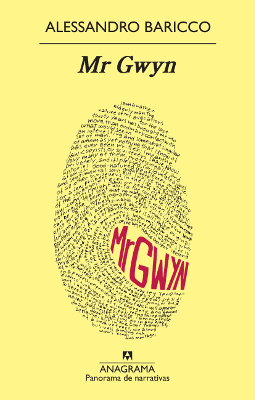 A successful British writer, Jasper White, decides at the age of forty not to write novels again. What will you do with your need to keep writing “something”? You still have the need to name, of using words to shape things that need to be expressed. So you decide to become “copyist”. He will make portraits of living people. And it won't make any description. How will you capture the essence of a person in words?
A successful British writer, Jasper White, decides at the age of forty not to write novels again. What will you do with your need to keep writing “something”? You still have the need to name, of using words to shape things that need to be expressed. So you decide to become “copyist”. He will make portraits of living people. And it won't make any description. How will you capture the essence of a person in words?
Thus begins the magnificent novel Mr White from the renowned Italian writer Alessandro Baricco (1958). Apart from its undeniable literary quality, to whom we are interested in him Focusing this novel gives us a novel vision of the symbolization of experience, nuclear for Focusing processes. Mr White, the main writer, is found on the front pages by chance at a portrait exhibition, and when reading the gallery's catalog, he is surprised to know how the painter of the paintings works. Mr Gwyn discovers something special:
Jasper Gwyn thought it must have taken a lot of time, a certain exile, as well as the dissolution of many resistances. He did not think of any technical tricks, nor did the painter's eventual mastery seem important., it only occurred to him that a patient action had set himself a goal, and in the end what he had managed to obtain was take back home to that man with a mustache. It seemed a very beautiful gesture. (Page 36)
And from there he embarks on an adventure in which he prepares a space taking care of all sensory aspects and creates an atmosphere where he can take portraits.. Capture the essence of a person in such a way that, como says Baricco, take the person home. It is inevitable to think about the Focusing process, and how through a welcoming and friendly presence it helps to symbolize the experience, so that the process is carried forward (a little closer to home, as Baricco would say). And regarding the process of symbolizing, offers a surprising opening (that I will not reveal here, because that belongs to the development of the novel itself).
For all this, essential for people interested in the Focusing process.
I am sure that at least it will help you to ask many new questions. And if you know other novels (or movies) that inspire us regarding Focusing, Nonviolent Communication or psychotherapy, Tell me about them and I will make your entries.
I wish you a pleasant reading,
Xavier
Bibliographic data: Baricco, Alessandro (2011): Mr White. Milan: Giangiacomo Feltrinelli Editore. Translation into Spanish by Xavier González Rovira (2012): Mr White. Barcelona: Anagram. Go to Anagrama publishing house, where you can read the first pages of the novel.
